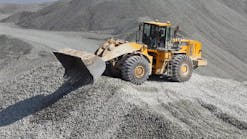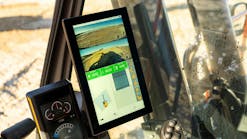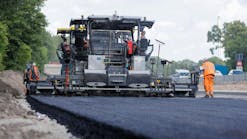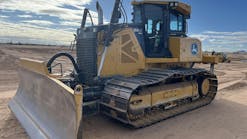Managing assets and production seems to get a little harder each day. As much as material costs can be counted on to rise, so can owners be counted on to be looking for yet another low-price deal to cut. The result is an ever-increasing management challenge to remain profitable, but one that technology can be a partner in helping contractors succeed.
Office workers have long enjoyed software tools that help with most every function they have to perform or manage. But field-based workers, especially construction workers, have had a rougher go of it. Early attempts by technologists to help contractors either better manage equipment maintenance or wring more productivity out of the equipment suffered from being overly complicated without producing much tangible bang for the buck. But the latest crop of software products, and the electronic developments that work with them, are giving contractors real help in managing costs while raising productivity. Taken as a whole, much of today's jobsite software is used for either equipment management or equipment operations.
Equipment ManagementDealers and rental managers have long enjoyed software that manages their inventory. But once the equipment had left the dealership and landed in a contractor's fleet, the scenario changed. Excel spreadsheets have served the earliest computer-savvy contractors, but a crop of equipment management software is now available that can move budgets farther in the black.
"Location-based services are literally transforming the way the industry does business," said Carolyn Rehling, vice president of construction and field services for Nextel.
In partnership with Trimble, it is offering the Construction Manager product, a GPS-powered system that helps construction professionals locate and manage assets at construction sites via Nextel handheld phones. According to Trimble, the solution effectively connects the office to the job site and is designed to reduce operating costs and improve construction efficiency.
The service available on Nextel handsets uses Nextel's iDEN network to deliver information to workers on job sites, such as the location of assets and employees, allowing them to locate and navigate to the assets needed to complete projects. In addition, jobsite boundaries, or "geo-fences," can be sent to the phone, allowing the solution to record site entry and exit events so site managers are notified if a worker enters a hazardous or un-safe zone. Users can also download maps and site designs to their Nextel wireless phone and view their current location superimposed on the design. This enables workers to perform reconnaissance activities such as inspecting terrain and visualizing how the site will be prepared.
"By teaming with a preferred cellular communications provider we can ... provide innovative, valued-added tools that improve the efficiency of construction site operations," said Michael Ritter, general manager of Trimble's construction services division.
Trimble also offers the Construction Asset Management System, consisting of the company's Construction Manager software and TrimTrac GPS locator, or the CrossCheck GPS communicator. It is designed to reduce project costs through enhanced asset utilization, improved safety, theft recovery, and an improved understanding of on-site operations. Ideal for managing multiple projects at the same time, the system displays equipment on a number of different maps — including topographic and street maps — and software provides customized reporting.
For fleet management Arsenault's latest is Version 4.0 of Dossier Fleet Maintenance software and the wireless Pocket to address time constraints. Among its many capabilities, Version 4.0 automates cost and budget control management by comparing a fleet's actual parts, labor and total costs to budget projections in real time. It also automates benchmark data of maintenance performance time and dollars with each repair-order entry. Similar to a PDA, the wireless hand-held Pocket Dossier is voice activated and bar-code enabled. In one scenario, a contractor using it may be walking around the fleet yard using your Pocket Dossier to update mileage meter readings. Should he see a vehicle in need of immediate attention, the unit's recent repair orders can be checked and a new repair order can be opened on the spot in real time.
For dispatching equipment, Senarch Systems sells Visual Dispatch 3.0 heavy equipment scheduling and billing software is an interactive, graphical user interface that allows the dispatcher to schedule equipment, employees and jobs with one click of the mouse. The application layout is easily modified. The software can be configured to handle different types of equipment and employee scheduling. Features include: mapping; web-view, chart and spreadsheet views; reports; popup reminders; color-coded pay terms and job warnings; job tickets; invoicing with accounting integration; operator cards and permits; repair tracking; and preventive maintenance.
Equipment OperationsMomentum has built so much so for laser- and GPS-powered technologies for contractors that they're just about a must-have for any serious contractor. For smaller and smaller jobs, the time and expense of installing and maintaining grade stakes is making contractors not using the technology increasingly struggle to submit competitive bids.
For firms just easing into the technology and still hesitant for the initial cash outlay, renting is a good way to "try before you buy." Topcon, for example, offers through some of its dealers an annual technology road show. A day is allocated at select locations where potential buyers spend time hearing about technology options, then either try out equipment fitted with the technology or ride along as a machine-control specialist demonstrates and explains.
Albany, N.Y.-based Callanan Industries attended a Topcon roadshow sponsored by Rochester, N.Y.-based dealer Admar Supply. Soon after, the firm was under contract to create at the State University at Albany two new ball fields dedicated to Division 1 field hockey and lacrosse. Callanan rented a John Deere 650 with fitted with 2-D laser and the RT5Sa laser. The challenge was that with both fields being artificial turf, drainage requirements demanded a high degree of accuracy. Elevation was also critical as it had to match the perimeter curbing. Callanan achieved near-perfect results.
For firms that would rather own the technology immediately, systems are available that provide simple reading. Apache's Bullseye 6 machine-control laser receiver can be fitted to hydraulic excavators and backhoes to provide offset/on-grade readings. An angle-compensation feature automatically calculates and corrects the grade display for the angle of the digging arm, and grade checks can be made with the arm extended or retracted up to 30 degrees. The Bullseye 6 works with all rotating lasers; provides 360-degree reception; allows a choice of accuracies; and is self-contained, permitting quick mounting and easy shifting to another machine.
Leica offers its MC200 Digger automated machine-guidance system for excavators, which allows the operator to dig quickly, accurately and on-grade from inside the cab — minimizing the need for workers in the trench. An LCD display panel indicates the bucket position in real time, relative to the desired finished grade. The Learn & Dig feature allows operators to set up multiple profiles within the cab, which allows for more flexibility on the job. A height warning for low and high elevations is built into the system.
Novariant's new Logic7D™ Excavate system was designed to boost the productivity of excavators by providing accurate, realtime positioning of the machine's bucket teeth. The system empowers equipment operators by displaying the grade and location of the bucket without the need for survey stakes. In addition, excavation can continue when a survey crew is not available, at night or in blinding conditions. Logic7D Excavate is powered by Novariant's new 7DDuo™ GPS Receiver, a dual antenna roof array that determines position and orientation of the machine, and a rugged touchscreen display that was specifically designed for the construction environment. The system also links a series of sensors through a controller area network (CAN/J1939) bus to compute the position of the bucket teeth with pinpoint accuracy. With this information overlaid on plan maps and design data, the equipment operator can efficiently control the bucket based on realtime cut/fill, slope location and depth information.
"Logic7D Excavate is a natural extension to what we have already delivered worldwide with our autosteering solutions for Agriculture, a turnkey solution that is open and built on industry standards," said Shashi Raval, CEO of Novariant.
Leica offers its MC1200 universal machine-control system is for earthmoving machines. The 1-D/2-D machine-control system combines a state-of-the-art user interface, CAN-bus architecture and industry-leading sensors. As a foundation for 3-D control, MC1200 has plug-and-play support for Leica's GradeStar TPS or GPS 3D system, giving the operator complete flexibility to select the best tool for the job.
GradeStar 3D machine-control systems can be based either on GPS technology (GradeStar 3D GPS) or robotic-total-station technology (GradeStar TPS, for Terrestrial Positioning System). In the latter system, the total station communicates via radio modem with the computer on the machine and measures the exact 3-D position of a prism target on the machine. Combined with the measured values of tilt sensors on a motor grader, the position and heading of the grader is continuously determined.
In 2005, John Deere Construction & Forestry Company began offering equipment that ships from the factory with hardware, software and wiring integrated and ready to support the use of global positioning systems (GPS) or laser guidance systems.
John Deere Construction & Forestry Company worked separate development agreements with two of the leading suppliers of GPS and laser-based guidance systems in the construction market to develop this technology for crawlers, graders and other machines. With an open architecture approach, the mobile construction equipment operates software from aftermarket guidance systems and enables control through an electrical interface, according to Brett Errthum, product marketing manager, John Deere Construction & Forestry Company. "John Deere's approach to automatic grade control provides the machine owner with the greatest flexibility. Regardless of which brand they use for site mapping and position sensing, John Deere machines will come ready for plug-and-play installations."
Enhanced SoftwareIs the topo on your bid documents accurate? Or will you end up importing more dirt than you expected on that lump sum contract? How many times have you wondered if your grading operations are efficient? How many yards is that dozer moving each day? How many more loads of select fill will you need to bring that building pad up to subgrade? Should you put 10 trucks on it tomorrow, or will five be enough to finish it? You've encountered a low area that's holding water — will you have enough fall to lead it around the building into a yard inlet?
These types of questions come up daily on the job site. Don't let your inhibitions about computers keep you from taking advantage of the new levels of control that you can achieve. The right software can you give on-the-spot answers to these typical issues and let you get back to work.
One program made just for contractors is Topcon's Pocket 3D, which is designed to work with the firm's System Five machine control systems, and GPS+ construction survey systems. It offers a contractor-friendly interface with touch-screen operation. Text size is large and easy to read. The commands are clear, easy to execute and are specifically designed for the routine functions that a contractor will need.
Pocket-3D simplifies contractors' data collection, allowing a user to check cuts and fills, layout points, and survey all or part of the job site. Grade checkers and foremen can use Pocket-3D to check grade anywhere on the site. Cut/fill information is constantly displayed on the screen. With Topcon GPS+RTK, one person can now control grade over the entire project for multiple machines.
Shaw Brothers Construction, based in Gorham, Maine, has completed many successful road projects for the Maine Department of Transportation. In 2005, they were involved in a major road construction project in Portland — the I-295 Connector. Steve Walton, construction supervisor for Shaw Brothers, used Topcon's Pocket 3D software with a HiPer+rover and FC-100 field computer to perform all stakeout for this complex project.
Walton built a comprehensive digital as-built record of installed improvements in the course of his daily routine using Pocket 3D. "It's like a filing cabinet. You can as-built the gas line, as-built the water line — anything you want on separate layers. I add each day's completed work as I go."
Having this information available at a moment's notice can prevent accidental damage to newly installed underground lines. He recalled a modification that had to be made in close proximity to underground lighting lines. "We know exactly where the electrical conduits are located," he said. "I just walk down through the area with my Pocket 3D-equipped rover and paint it out on the ground."
Office 3D is a companion program to Pocket 3D that is designed for use on office and notebook PCs. This master program can import AutoCAD files, then export surface, line and point files to Pocket 3D or to a flash card for use with Topcon's machine control boxes. A 3-D simulator enables the user to drive machine across the job site and check the design for errors.
Dave Kruskamp and Leroy Brechtelsbauer work for Fisher Contracting in Midland, Michigan. Kruskamp is a foreman/surveyor and Brechtelsbauer operates a Cat D6N dozer. These two men work together as a team to manage earthmoving on the company's projects. They rely on Topcon's complete site management system to perform all required tasks with a seamless exchange of data.
Kruskamp uses Topcon's Hiper+ rover, FC-100 field computer and Pocket 3D software for layout, grade checking and earthwork analysis tasks. Using Topcon's 3D Office, he creates the point files needed for layout and the 3-D surface files required for the dozer machine control system. Data files are compatible between all components of this complete site management system.
The seamless exchange of digital data expedites the coordination and control of field operations: "On big dirt moving jobs, Leroy can topo with the bulldozer and we can figure layers — how much he took out that day," Kruskamp explained. "We can use it to track quantities. I might be on a different job. He can e-mail it to me and I can figure the amount that he's removed or how much he has to go down on my laptop computer or right on my rover with Topcon's Pocket 3D."
Construction personnel with survey or engineering experience will find powerful design and site analysis features in Topcon's TopSite software. This CAD-based software program can be used to design an entire project or create a 3-D site simulation to check for errors in the design file. TopSite also creates DTM's (Digital Terrain Models) for a project and can import Terramodel, AGTEK, Land Development, and Microstation files.
McGowan-Stauffer Inc. is a mid-sized earthwork and storm drainage contractor. Based in Carnegie, Pennsylvania, MSI typically works on two or three projects in the $500,000 range at any given time. They have a permanent office staff of eight and employ as many as 20 operators during optimal weather months.
While MSI is like many other site prep contractors, they have a distinct advantage — site engineering savvy. Phil McGowan and George Stauffer, both civil engineers, started their contracting company in 1975. Today Don McGowan, second-generation civil engineer, is strengthening his relationships with owners by offering technically sound advice on how to reduce site work costs.
Recently MSI contracted to prep a hilltop site for a commercial project. Earthwork calculations revealed that 750,000 cubic yards of earth had to be moved to create the desired building and parking areas. The plans included an extensive array of multiple retaining walls around the perimeter of the site. Using Topcon's TopSite software program, McGowan studied alternatives to the retaining walls.
McGowan developed a grading plan that eliminated the need for the walls with minimal impact on the proposed development area. This resulted in a cost savings of $800,000. To help the owner visualize his proposed changes, he used TopSite to create a 3-D model.
On the same project, the owner wanted to acquire an adjoining lot for access to increase his developable site area. McGowan prepared a plan and 3-D model in TopSite showing the driveway extending onto the neighboring land. He took his notebook computer to a meeting with the owner and adjoining property owner. Projecting his concept on a TV monitor, he was able to visually communicate his proposal.




